READY TO GET STARTED?
REQUEST A FREE ESTIMATE
Fill out the form below or call (888) 466-7849 for a free, no-obligation estimate.
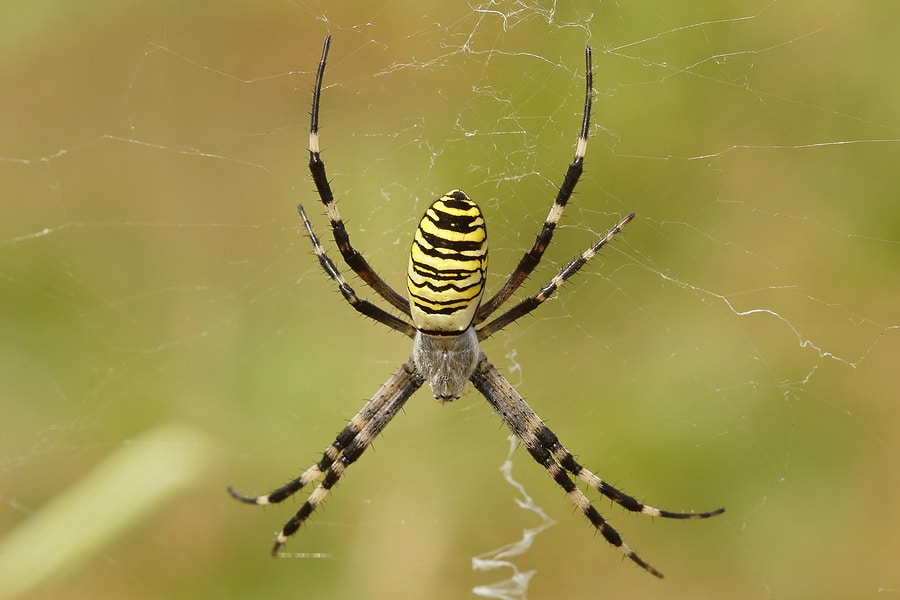
Orb weaver spider is the collective name for a group of spiders in the family Araneidae. This diverse group of arachnids are famous for the large, Halloween-inspired webs they create. Are orb weavers venomous? Should we be concerned when we encounter one in our yard or garden? The short answer to these questions is yes, they are venomous but no, they aren’t dangerous to humans. Let’s take a closer look at this fascinating species of spider.
Orb weavers are large spiders that are most commonly seen in late summer and early fall. They eat small insects like flies, moths, wasps, mosquitoes, and beetles. Around your home, orb weavers can often be found near outdoor lights, in tall grass and weeds, on tree branches, fences, walls, and bushes. There are 180 species of orb weaver spiders in North America alone. They are found throughout the world on every continent except Antarctica. Many species of orb weavers are bright yellow or orange in color while others are a dull gray or brown.
Orb weavers are not hunters or wanderers. They are typically nocturnal spiders and will build or repair their webs at night. Many species will tear down and eat their webs at dawn to both consume the dew that catches on them for hydration and to keep larger animals like birds from tearing down their webs. Orb weaver webs are large, circular grid webs that look like the spokes of a wagon wheel connected by concentric circular strands. These webs can measure up to 3 feet in diameter. These spiders will sit in their webs and wait for prey. Once captured, they will bite and paralyze their victim and warp them in silk to consume later.
While orb weaver spiders can bite and are venomous, they are not considered a threat to humans. In fact, they are beneficial to have around your home as they eat other nuisance pests and help keep their populations under control. These spiders are very docile and non-aggressive. They will usually flee when threatened but will bite if necessary. The bite of an orb weaver has been compared to a bee sting.
While they don’t threaten humans or structures, they can be unsightly and their webs can be a hindrance if built in a high traffic area. If you have a problem with spiders or any other pests, contact your local pest control company for assistance with pest control and prevention.
What to Know About Overwintering Pests
Protecting Your Business’s Outside Space
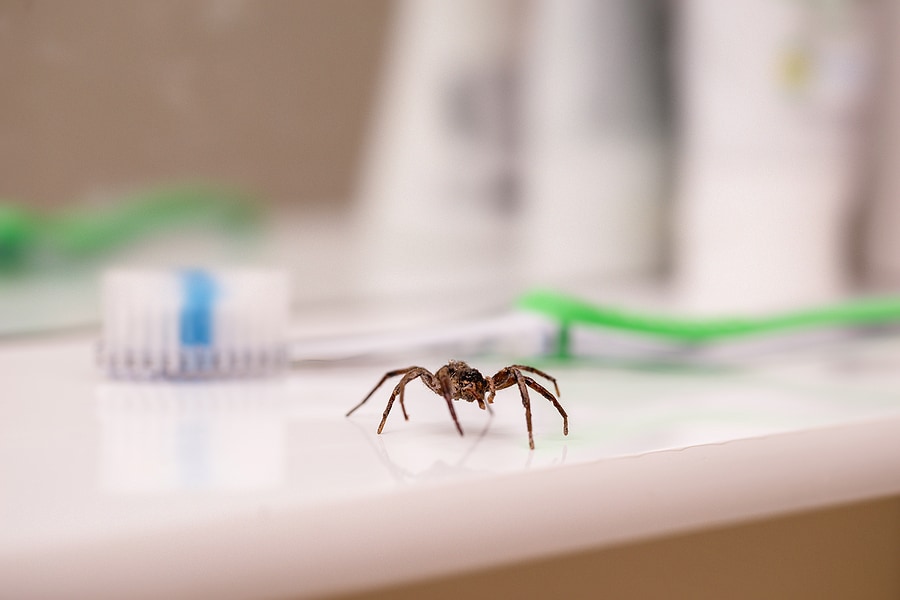
Creepy and crawly, spiders can easily sneak into homes without you noticing. Most spiders that homeowners come across are harmless; but if you don’t take precautions, you can find them infesting your home. Below are some easy, do-it-yourself tips for spider prevention.
Clean Up Clutter
Spiders tend to look for dark, secluded areas to inhabit. You can often find them in rooms that have clutter, such as basements and attics. To keep these pests from infesting, keep garages, sheds, attics, basements, and other areas that aren’t utilized very often clean and clear of clutter.
In your regularly used rooms, be mindful of leaving clothes or clutter around the house. Try to avoid leaving clothes and shoes on the floor and instead, consider storing them in plastic bins. Shake out any clothing left on the floor and in the hamper.
Repair and Seal
The smallest gap or hole can allow spiders right into your home. Look around the inside and outside of your home and search for any open holes or gaps. Inspect your window screens, doors, and siding, as these are places that can provide openings leading inside.
If you find openings, seal them as soon as possible to eliminate the chance of these pests from entering. Make sure to inspect your house seasonally and provide any repairs.
Check Before Entering
Packages, secondhand furniture, and even groceries provide a perfect gateway inside homes for spiders. These pests will often hitch a ride on these items without you noticing. Make sure to inspect all packages delivered to your porch or steps, groceries as you unload them, boxes of decorations brought in from storage, and used appliances and furniture bought secondhand.
Spotting spiders can be difficult, but once you see them or suspect that you have a problem, it’s best to call your local pest control company to help eliminate and prevent them. A service professional will inspect the exterior and interior of the home to identify and provide you with the best plan of action to treat them.
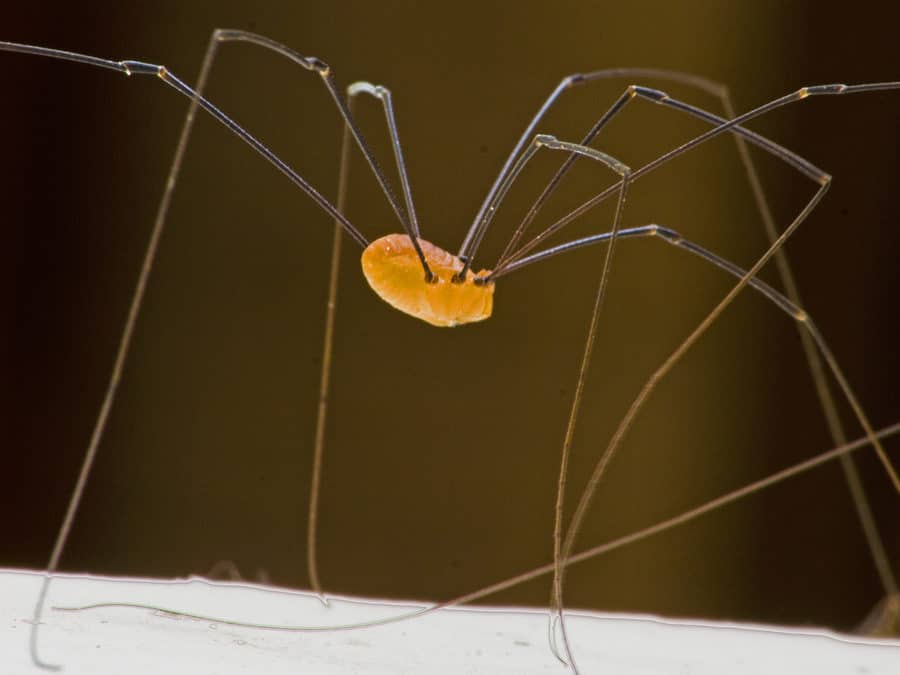
According to popular belief, the granddaddy long leg is the most poisonous spider in the world. While the origins of this myth are unknown, we do know one thing for certain: granddaddy long legs are not spiders and they aren’t poisonous (or venomous for that matter).
Granddaddy long legs, also known as harvestmen, are often mistaken for spiders because of their spider-like appearance and movements. While they do have some spidery characteristics, they are not, in fact, spiders. They are classified as arachnids like spiders because of their 8 legs and movements similar to their spider cousins. Other arachnids that aren’t spiders include ticks, mites, and scorpions. Despite their appearance, granddaddy long legs are actually more like scorpions than spiders. Spiders have 8 eyes while granddaddy long legs only have 2. Spiders also have a distinct waist separating their thorax/head from their abdomen while granddaddy long legs have one fused cavity containing their head, thorax, and abdomen. Finally, spiders produce silk and spin webs. Granddaddy long legs do not produce silk so they can’t make webs.
Poisonous and venomous are often confused, especially when it comes to pests. Poisonous creatures cause harm through touching or ingesting. Venomous creatures cause harm through injection of venom. As far as humans are concerned, granddaddy long legs are neither poisonous or venomous.
Granddaddy long legs do have fang-like mouth parts (also known as chelicerae) that they use to grasp and chew food but they are not used to bite humans nor inject venom. These arachnids have developed some rather unique methods of defense from predators. First, they have a set of stink glands that they deploy to help ward off predators. They also have been known to curl up and play dead when disturbed. The most unique defense mechanism, however, is their ability to shed their legs when grabbed (also known as autotomy). Unfortunately, once they shed an appendage they are unable to grow it back.
Because they pose no threat to humans (and, in fact, feed on other smaller insects that may be in and around your home), you don’t necessarily need to get rid of them should you stumble across one. They prefer dark, moist environments and are often found in crawl spaces, basements, and garages. The best way to get rid of a granddaddy long leg is to sweep or vacuum it up.
Because what attracts granddaddy long legs are smaller pests they can prey on, seeing a large number of them in your home can indicate another pest control issue. If you suspect you have a pest problem, contact a professional pest control company who can help with pest and spider identification and the best course of treatment and future prevention.
Is That Bird’s Nest Dangerous?
Why You Still Need Pest Control This Winter
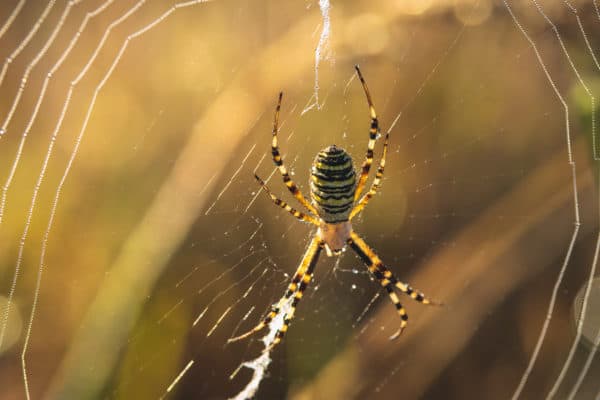
As you break out your fall decorations, you may have noticed an abundance of spider webs or had a spider run across your hand; now the house must burn! WAIT – before you jump to meme-worthy conclusions, spiders do act as nature’s form of pest control; however, having them in your home is not ideal. Follow these tips to prevent spider encounters in your home so that you can enjoy hanging up fake cobwebs without stumbling upon a real one.
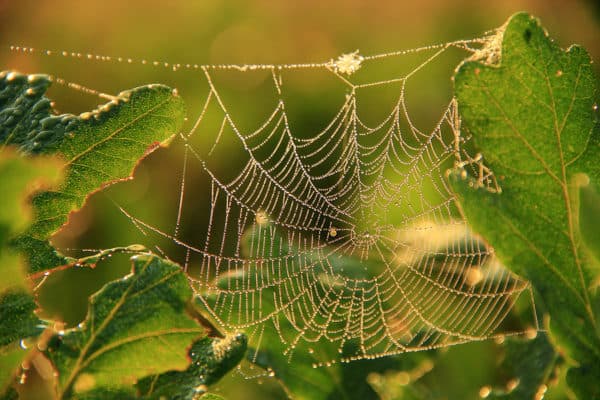
One of the most common questions that arises when a spider is found in a home is “is that spider poisonous?” That’s a trick question. Most spiders are poisonous, yet only a handful are venomous. Poisonous spiders release their toxins when they are inhaled, ingested or absorbed through the tissue or skin; in other words, they’re only harmful if you eat them. Venomous spiders, on the other hand, inject their toxin with a fang-like apparatus known as a chelicerae. These are the spiders you should be worried about and avoid contact with.
While there are more than 20 species of spiders in Georgia, there are only 2 that are known to be dangerous to humans: the black widow and the brown recluse. Like most common spiders, biting humans is a last line of defense. They are more likely to flee, hide, or even play dead rather than bite a human. It takes a long time for a spider to replenish his supply of venom after he injects it. Most will only use this defense mechanism if they have no other choice. Wasting venom on a human can even cause the spider to starve to death before his supply is replenished as he will have no means to kill any prey he catches.
Let’s take a closer look at each of the venomous spider species in Georgia, as well as some general tips to prevent spiders from getting into your home.
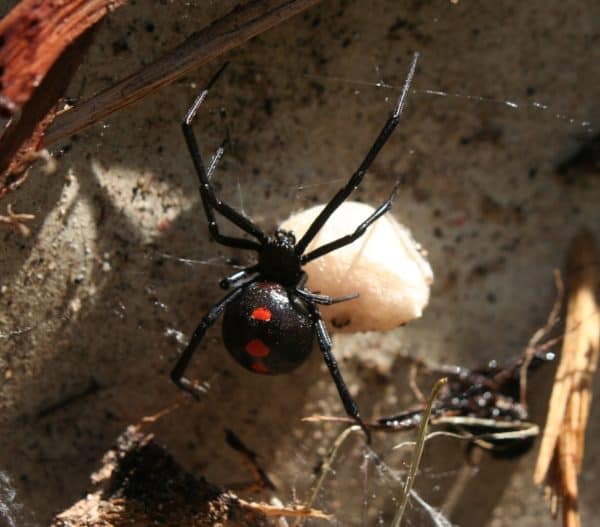
The black widow spider is considered to be the most venomous spider in North America. It is only the female black widow, however, that is dangerous to humans. Black widows are a red and black spider that is usually about 1.5 inches long with a shiny, globular abdomen and a reddish hourglass shape on its underside. While they are mostly black in color, they can sometimes be brown. The venom of a black widow spider is reportedly 15 times stronger than that of a rattlesnake. While black widow bites can be fatal to the young, the elderly, and those with compromised immune systems, most victims suffer no serious or long term damage from the bite. Black widows are not aggressive and bites commonly occur as a result of accidental contact. Common symptoms from a black widow bite include redness, swelling and tenderness at the site of the bite, muscle aches, nausea, and sometimes paralysis of the diaphragm which can cause difficulty breathing.
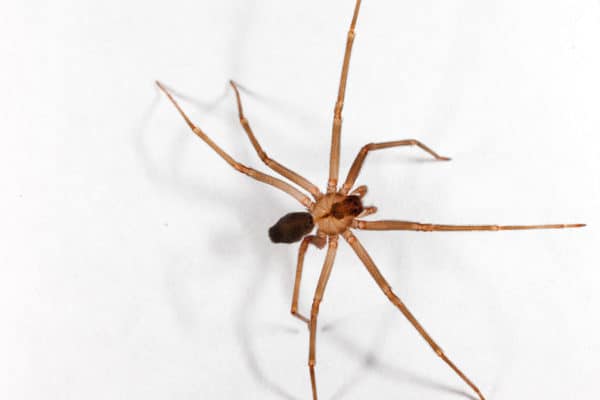
The brown recluse spider is also known as the violin spider or the fiddleback spider. The brown recluse is a light brown spider with a dark, violin-shaped marking on its back with the neck of the violin pointing toward the rear of the spider. They also have a very distinctive eye pattern with a semi-circular arrangement of 6 eyes (3 sets of 2) while most spider species have 8 eyes. Adult brown recluses are about the size of a quarter. They usually live outdoors under rocks, woodpiles, logs, etc. but are also well adapted to living indoors with humans. Once inside they are commonly found in attics, garages, basements, and are even known to wander into shoes, clothing, and bedding. They hunt at night and retreat to dark, secluded places in the daytime. The brown recluse is typically not aggressive and usually only bite when they are inadvertently trapped against human skin (rolling over on them in the bed or slipping your foot into a shoe they have crawled into for hiding). While bites are rare they can cause serious wounds and infections. The majority of bites remain localized, becoming red, swollen and tender at the site of the bite. If left untreated, a necrotic lesion may develop, usually accompanied by a central blister.
Keep your garages, attics, sheds, basements, and other areas that aren’t utilized often clean and clear of clutter. Try to avoid leaving clothing and shoes on the floor and store them in plastic bins if possible. Shake out any clothing that has been left on the floor or in a hamper before wearing or washing.
Seal any cracks and crevices around your home. Spiders can get in through damaged window screens or cracks in your siding. Inspect the outside of your home seasonally and make any repairs necessary.
Inspect any items that are brought from outdoors into your home. This includes any packages delivered to your porch or steps, groceries that may be placed on the driveway or porch as you are unloading, boxes of decorations being brought in from storage, or used appliances that are bought secondhand.
Contact a licensed pest control company if you suspect you have a spider problem. A professional pest control technician can inspect the exterior and interior of your home to help identify any possible entry points, identify the type of spiders and other pests you may be having issues with, and properly, safely, and effectively treat any pest problems they may encounter.
Request a Free Estimate to Get Started.
Avoid Bites and Stings This Summer
The Summer Big Three: Roaches, Mosquitoes, & Termites